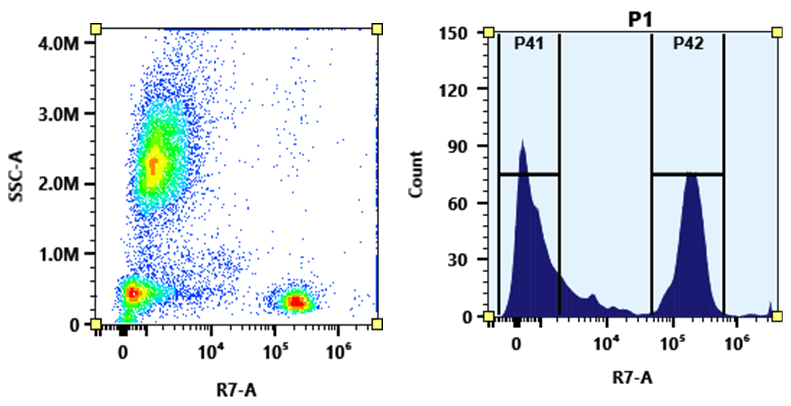Buccutite™ Rapid APC-Cy7 Tandem Antibody Labeling Kit
Microscale Optimized for Labeling 100 ug Antibody Per Reaction
APC-Cy7 is a popular color used in flow cytometry. Its primary absorption peak is at 651 nm with emission peak at ~780 nm. AAT Bioquest offers this Buccutite™ rapid labeling kit to facilitate the APC-Cy7 tandem conjugations to antibodies and other proteins such as streptavidin and other secondary reagents. Buccutite™ APC-Cy7 Tandem Conjugation Kit provides a robust and convenient method to conjugate antibodies with APC. The kit includes a preactivated APC-Cy7 tandem and reaction buffer. The conjugated antibody can be used in flow cytometry, WB, ELISA and IHC applications. This kit is sufficient for 2 labeling reactions, each up to 100 ug of antibody. The best ratio for any new antibody reagent must be determined by experimentation. Our kit provides preactivated APC-Cy7 tandem to facilitate the APC-Cy7 tandem conjugations to antibodies and other proteins such as streptavidin and other secondary reagents. Our preactivated APC-Cy7 tandem is ready to conjugate, giving much higher yield than the conventionally tedious SMCC-based conjugation chemistry. In addition, our preactivated APC-Cy7 tandem is conjugated to a protein via its amino group that is abundant in proteins while SMCC chemistry targets the thiol group that has to be regenerated by the reduction of antibodies.


| Catalog | Size | Price | Quantity |
|---|---|---|---|
| 1321 | 2 Labelings | Price |
Spectral properties
| Extinction coefficient (cm -1 M -1) | 700000 |
| Excitation (nm) | 651 |
| Emission (nm) | 779 |
Storage, safety and handling
| H-phrase | H303, H313, H333 |
| Hazard symbol | XN |
| Intended use | Research Use Only (RUO) |
| R-phrase | R20, R21, R22 |
| UNSPSC | 12171501 |
Documents
Contact us
| Telephone | |
| Fax | |
| sales@aatbio.com | |
| International | See distributors |
| Bulk request | Inquire |
| Custom size | Inquire |
| Technical Support | Contact us |
| Request quotation | Request |
| Purchase order | Send to sales@aatbio.com |
| Shipping | Standard overnight for United States, inquire for international |
Page updated on December 15, 2025

